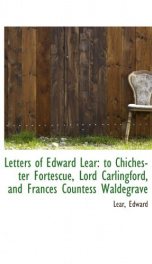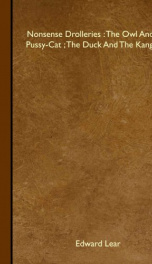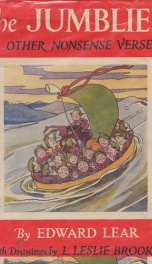Lear Edward

Edward Lear (12 May 1812 – 29 January 1888) was an English artist, illustrator, author, and poet, renowned today primarily for his literary nonsense, in poetry and prose, and especially his limericks, a form that he popularised. Lear was born into a middle-class family in the village of Holloway, the 21st child of Ann and Jeremiah Lear. He was raised by his eldest sister, also named Ann, 21 years his senior. Ann doted on Lear and continued to mother him until her death, when Lear was almost 50 years of age.[1] Due to the family's failing financial fortune, at age four he and his sister had to leave the family home and set up house together. Largely educated by himself, Lear has been described as idiosyncratic yet brilliantly talented . Lear also suffered from health issues. From the age of six he suffered frequent grand mal epileptic seizures, and bronchitis, asthma, and in later life, partial blindness. Lear experienced his first seizure at a fair near Highgate with his father. The event scared and embarrassed him. Lear felt lifelong guilt and shame for his epileptic condition. His adult diaries indicate that he always sensed the onset of a seizure in time to remove himself from public view. How Lear was able to anticipate them is not known, but many people with epilepsy report a ringing in their ears or an "aura" before the onset of a seizure. In Lear's time epilepsy was believed to be associated with demonic possession, which contributed to his feelings of guilt and loneliness. When Lear was about seven he began to show signs of depression, possibly due to the constant instability of his childhood. He suffered from periods of severe depression which he referred to as "the Morbids." [2] Lear travelled widely throughout his life and eventually settled in Sanremo, on his beloved Mediterranean coast, in the 1870s, at a villa he named "Villa Tennyson." The closest he came to marriage was two proposals, both to the same woman 46 years his junior, which were not accepted. For companions he relied instead on a circle of friends and correspondents, and especially, in later life, on his Suliot chef, Giorgis, a faithful friend and, as Lear complained, a thoroughly unsatisfactory chef.[3] Another trusted companion in Sanremo was his cat, Foss, who died in 1886 and was buried with some ceremony in a garden at Villa Tennyson. After a long decline in his health, Lear died at his villa in 1888, of the heart disease from which he had suffered since at least 1870. Lear's funeral was said to be a sad, lonely affair by the wife of Dr. Hassall, Lear's physician, not one of Lear's many lifelong friends being able to attend.[4] Lear was already drawing "for bread and cheese" by the time he was aged 16 and soon developed into a serious illustrator; his first publication, published when he was 19, was Illustrations of the Family of Psittacidae, or Parrots in 1830. His paintings were well received and he was favourably compared with Audubon. Lear travelled for three years in Italy and published two volumes of illustrations, Illustrated Excursions in Italy. Lear briefly gave drawing lessons to Queen Victoria, who had been pleased by the Excursions and summoned him to court, leading to some awkward incidents when he failed to observe proper court protocol. Lear then returned to the Mediterranean, wishing to illustrate all points along the coast of that sea. Throughout his life he continued to paint seriously. He had a lifelong ambition to illustrate Tennyson's poems; near the end of his life a volume with a small number of illustrations was published, but his vision for the work was never realized. In 1846 Lear published A Book of Nonsense, a volume of limericks that went through three editions and helped popularize the form. In 1865 The History of the Seven Families of the Lake Pipple-Popple was published, and in 1867 his most famous piece of nonsense, The Owl and the Pussycat, which he wrote for the children of his patron Edward Stanley, 13th Earl of Derby. Many other works followed. Lear's nonsense books were quite popular during his lifetime, but a rumour circulated that "Edward Lear" was merely a pseudonym, and the books' true author was the man to whom Lear had dedicated the works, his patron the Earl of Derby. Supporters of this rumour offered as evidence the facts that both men were named Edward, and that "Lear" is an anagram of "Earl".[5] Lear's nonsense works are distinguished by a facility of verbal invention and a poet's delight in the sounds of words, both real and imaginary. A stuffed rhinoceros becomes a "diaphanous doorscraper". A "blue Boss-Woss" plunges into "a perpendicular, spicular, orbicular, quadrangular, circular depth of soft mud". His heroes are Quangle-Wangles, Pobbles, and Jumblies. His most famous piece of verbal invention, a "runcible spoon" occurs in the closing lines of The Owl and the Pussycat, and is now found in many English dictionaries: Though famous for his neologisms, Lear employed a number of other devices in his works in order to defy reader expectations. For example, "Cold Are The Crabs",[6] adheres to the sonnet tradition until the dramatically foreshortened last line. Limericks are invariably typeset as four plus one lines today, but Lear's limericks were published in a variety of formats. It appears that Lear wrote them in manuscript in as many lines as there was room for beneath the picture. In the first three editions most are typeset as, respectively, two, five, and three lines. The cover of one edition[7] bears an entire limerick typeset in two lines: In Lear's limericks the first and last lines usually end with the same word rather than rhyming. For the most part they are truly nonsensical and devoid of any punch line or point. They are completely free of the off-colour humour with which the verse form is now associated. A typical thematic element is the presence of a callous and critical "they". An example of a typical Lear limerick: Lear's self-portrait in verse, How Pleasant to know Mr. Lear, closes with this stanza, a reference to his own mortality: Five of Lear's limericks from the Book of Nonsense, in the 1946 Italian translation by Carlo Izzo, were set to music for choir a cappella by Goffredo Petrassi, in 1952. Eagle Owl, Edward Lear, 1837 Another Edward Lear owl, in his more familiar style Lear self portrait, illustrating a real incident when he encountered a stranger who claimed that "Edward Lear" was merely a pseudonym. Lear (on the right) is showing the stranger (left) the inside of his hat, with his name in the lining.
do you like this author?
What readers are saying
What do you think? Write your own comment on this book!
write a commentWhat readers are saying
What do you think? Write your own comment on this author!
write a commentBook list

Nonsense DrolleriesThe Owl & The Pussy-Cat—The Duck & The Kangaroo.
Series:
Unknown
Year:
Unknown
Raiting:
3.5/5
Show more
add to favoritesadd In favorites

the complete nonsense book containing all the original pictures and verses tog
Series:
Unknown
Year:
Unknown
Raiting:
4.5/5
Show more
add to favoritesadd In favorites
Book list

Nonsense DrolleriesThe Owl & The Pussy-Cat—The Duck & The Kangaroo.
Series:
Unknown
Year:
Unknown
Raiting:
3.5/5
Show more
add to favoritesadd In favorites

the complete nonsense book containing all the original pictures and verses tog
Series:
Unknown
Year:
Unknown
Raiting:
4.5/5
Show more
add to favoritesadd In favorites

programa de la enseanza que dege observarse en el colegio del estad el ao d
Series:
Unknown
Year:
Unknown
Raiting:
4/5
Show more
add to favoritesadd In favorites

letters of edward lear to chichester fortescue lord carlingford and frances c
Series:
Unknown
Year:
Unknown
Raiting:
5/5
Show more
add to favoritesadd In favorites

letters of edward lear to chichester fortescue lord carlingford and frances
Series:
Unknown
Year:
Unknown
Raiting:
3/5
Many of the earliest books, particularly those dating back to the 1900s and before, are now extremely scarce and increasingly expensive. We are republishing these classic works in affordable, high quality, modern editions, using the original text and artwork.
Show more
add to favoritesadd In favorites

later letters of edward lear to chichester fortescue lord carlingford lady w
Series:
Unknown
Year:
Unknown
Raiting:
3/5
Show more
add to favoritesadd In favorites

journals of a landscape painter in southern calabria c
Series:
Unknown
Year:
Unknown
Raiting:
5/5
Show more
add to favoritesadd In favorites

Nonsense Drolleries
Series:
Unknown
Year:
Unknown
Raiting:
4.5/5
Many of the earliest books, particularly those dating back to the 1900s and before, are now extremely scarce and increasingly expensive. We are republishing these classic works in affordable, high quality, modern editions, using the original text and artwork.
Show more
add to favoritesadd In favorites
What readers are saying
What do you think? Write your own comment on this author!
write a commentGenre
- Books
- Books / Children's Books / Literature
- Books / Children's Books / Authors & Illustrators, A-Z
- Nonfiction / Politics / General
- Literature & Fiction / History & Criticism / Criticism & Theory
- Religion & Spirituality / Christianity / Reference / New Testament
- Nonfiction / Education / Education Theory / History
- Reference / Atlases & Maps / World
if you like Lear Edward try:
readers also enjoyed
What readers are saying
What do you think? Write your own comment on this author!
write a commentGenre
- Books
- Books / Children's Books / Literature
- Books / Children's Books / Authors & Illustrators, A-Z
- Nonfiction / Politics / General
- Literature & Fiction / History & Criticism / Criticism & Theory
- Religion & Spirituality / Christianity / Reference / New Testament
- Nonfiction / Education / Education Theory / History
- Reference / Atlases & Maps / World
if you like Lear Edward try:
readers also enjoyed
Do you want to exchange books? It’s EASY!
Get registered and find other users who want to give their favourite books to good hands!



